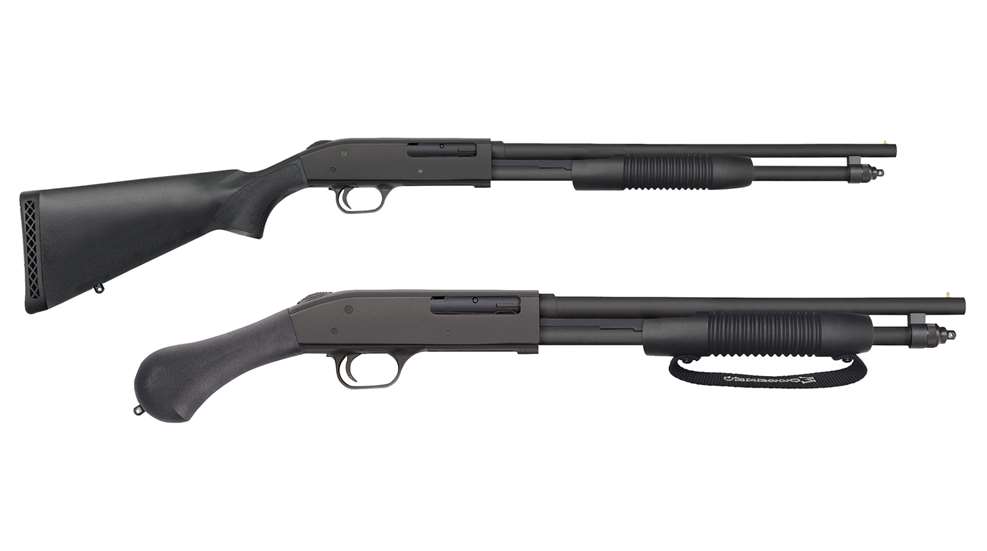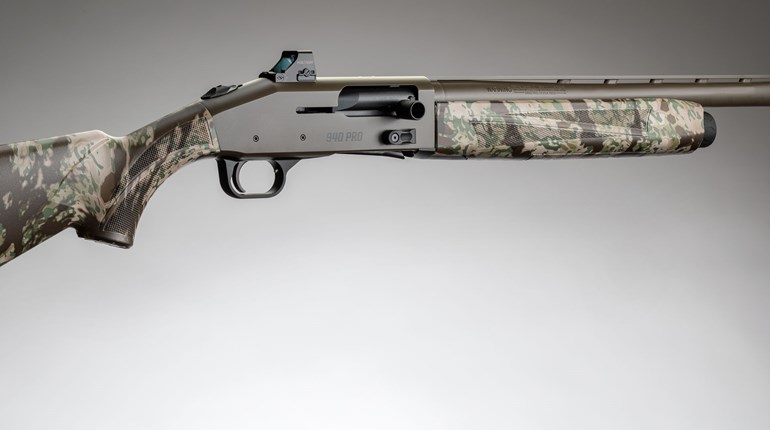
Mossberg’s 590, available as a standard shotgun and also as a “firearm,” is a solid host for a .410-bore defensive scattergun.
Recently, I’ve received several letters asking my opinion of a .410-bore shotgun for home defense.
First off, the only living beings I’ve thwarted with a .410-bore are a few rattlesnakes, a passel of rabbits and a small mountain of squirrels. So, anything I opine about this arm for home defense is strictly that: opinion. Nonetheless, here goes, but not without a structured approach.
.410 Shotgun as a Defensive Tool
In theory, .410-bore should be a viable tool for self-defense because it’s a scaled-down version of a 12-gauge. Obviously, it offers a smaller payload and therefore less overall energy downrange, but it still offers the benefit of a pattern, albeit a small one. Realistically we’re talking a few-inch-wide pattern at across-the-room distances, but that’s an increase over a single projectile. What’s more, recoil is less, as is overall gun weight, a stat rarely mentioned by shotgun advocates, but one that’s very real the moment a 12-gauge must be held with one hand while the other hand is busy. Frankly, there are many good reasons for choosing a .410-bore, but before I get to them here are some facts.
... my favorite for home defense are those 3-inch loads that deliver five 000 buckshot (.36-caliber, 68-grain) pellets at around 1,125 fps to produce roughly 950 ft.-lbs. of collective energy at the muzzle.
Ballistic Data
Although various .410-bore loads abound, my favorite for home defense are those 3-inch loads that deliver five 000 buckshot (.36-caliber, 68-grain) pellets at around 1,125 fps to produce roughly 950 ft.-lbs. of collective energy at the muzzle. That’s roughly half the energy of a 12-gauge, 9-pellet 00 buck load, but about 2.5 times that of a typical 9 mm. (Why 000 pellet size? Since even 00 buck pellets must be stacked single-file in the .410’s hull, the 000 load offers more lead and less wasted space.)
Free recoil is a complex equation involving payload weight, velocity of the ejecta and gun weight, so because the aforementioned 000 load weighs about .7 ounce—significantly less than a common 1.25-ounce 12-gauge load—the shell itself produces significantly less recoil. However, you must factor that most .410 guns weigh substantially less than 12-gauges, something that increases the felt recoil of a .410-bore. If we figure the average weight of a loaded 12-gauge is 8 pounds compared with the average weight of a loaded .410 at 6.5 pounds, the calculations are as follows: The .410 produces about 10 ft.-lbs. free-recoil energy (that’s about that of a .243 Win.) while the 12 gauge wallops you to the tune of 32 ft.-lbs., or three times the amount. (The 12-gauge is about like shooting a .300 Weatherby Mag. and by most folks’ standards, not a lot of fun.) Now, for those shooting a 29-ounce Taurus Judge (let’s call it 2 pounds fully loaded) the .410 produces recoil similar, at about 30 ft.-lbs. That’s no fun at all from a handgun, and in fact very difficult to control. But, that is why plenty of companies, including Federal, have produced reduced-velocity (low-recoil) loads specifically for the Judge.
Reliability
The feeding mechanisms of repeating guns are tricky. In general, long and narrow cartridges feed more poorly than fatter, shorter cartridges. (This is the reason why .22 LRs are generally more reliable than .22 Mag. rounds in semi-automatic actions.) While plenty of .410-bore pumps, lever-actions and semi-autos exhibit good reliability, historically they have never been the most reliable, and few could be called “ultra-reliable” when compared to popular pistol rounds or 12- and 20-gauge shotguns. Revolvers, single shots and multi-barrel shotguns, on the other hand, are supremely reliable, of course, but whether you want a non-repeating shotgun as your primary home-defense arm is another question altogether.
Shell Options
Nominal .410-bore loads include 2½- and 3-inch birdshot (No. 6, 7, 8, or 9), 000 buck, quarter-ounce slug and buck and slug duplex loads, such as Hornady’s Triple Defense. But, like most shotgun shells, you can find all types of novelty loads, and if you are unsatisfied with those on the market, you can always load your own.
So now that we’ve looked at the specs, what are my final thoughts on the .410-bore for self-defense? Even fired through a full choke—which is what most .410 shotguns are choked from the factory—that pattern of four or five 000 pellets is more devastating than any common pistol round, and will increase your margin for error for when you’re rubbing the sleep from your eyes in the middle of the night. If I chose a .410, I’d definitely choose the 000-buck load because the birdshot pattern is both thin as a whole and lacking in individual pellet energy when each splits from the swarm. Although a slug load would certainly do the job, if you choose a slug you might as well choose a much more accurate and reliable carbine or rifle, and I say this when talking about 12 gauges, too. Reliability isn’t stellar.
In my view, trimmer gun weight and lower recoil are the two main reasons for choosing the little .410. For people who want the power and assuredness of a shotgun without the massive recoil and bulk of a full-size 12-gauge, a 6.5-pound, historically reliable .410 like a Mossberg 590 pump is a bona fide option. (Remember, if recoil is the main reason for you choosing a .410, don’t negate its advantage by choosing an ultra-lightweight gun.)
But, here’s what I really think: For most Americans, if you’re thinking about a defensive shotgun, you should first look at the 12-gauge; if you need something smaller with less recoil, strongly consider a 20-gauge because it’s a huge leap in performance from the little .410. I’m not knocking it or saying it can’t be a viable defender of the home, because it certainly can. Rather, I think the number one reason for specifically choosing the .410-bore to protect your door is … it’s what you have. And that’s enough reason for me.




































